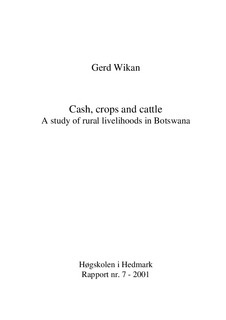Cash, crops and cattle. A study of rural livelihoods in Botswana
Research report
Permanent lenke
http://hdl.handle.net/11250/133988Utgivelsesdato
2001Metadata
Vis full innførselSamlinger
Sammendrag
Lack of economic development has lead to a growing scepticism to grand economic
development theories and strategies. The focus has shifted towards a more open-ended
perspective where the local context and poverty alleviation are in focus. As a result,
the new key concepts in the discourse are livelihoods and urban-rural linkages. The
academic interest is focused on the question: how are African households surviving
given their increasing difficult economic circumstances?
In the African context, Botswana is a special case. It is rich; it has a very small and
relatively homogenous population and has had a stable democratic development
throughout the whole independence period. Situated in the land-locked central part of
Southern Africa the peaceful and successful development of Botswana is quite an
achievement. However, Botswana’s economic progress and development has not had
the anticipated spread effects, from the urban to the rural economy, from the privileged
to the poor. Poverty amidst plenty is an often-used slogan to describe the present state
of development in Botswana. The development processes is a differentiation process,
and at the present stage a number of households live in utmost poverty, whereas
Gaborone was given the name Benz City because of the number of Mercedes Benz
around. On this background on wealth and poverty, I will show how different groups
of rural households are making a living; how the poor are managing to stay alive, how
the middle income households are planning for survival and security and how the rich
are making sure they stay rich and continue accumulating wealth. In short, the main
focus of this report is the livelihood strategies of the rural households.
